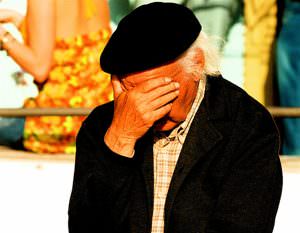Relax, Relax at the Dying of the Light
AARP magazine, which boasts the largest circulation of any periodical in the world, used to focus on injustice, something it now calls "negativity."
By Thomas Hedges, Center for Study of Responsive Law
Welsh poet Dylan Thomas told his ailing father that he should fight encroaching death, not in the hope of evading it, but as something to which he would refuse to bow down. “Old age should burn and rave at close of day,” Thomas wrote in his famous poem. “Do not go gentle into that good night,” he urged. “Rage, rage against the dying of the light.”
Sixty years later we live at odds with Thomas. There is little rage and vigor that comes after retirement. Usually it’s bingo. We play it in a sequestered nursing home or on a cruise ship during vacations that might as well be anywhere in the world. Either way, we don’t really care what’s going on outside. We’re old.
We move down to Florida if we can afford it. We can play golf every day and live in gated communities where real life is kept out. We can walk slowly on the beach and read lifestyle magazines that reduce living to health, happiness and saving money.
Indeed these are the tenets of AARP magazine, which is geared toward people ages 50 and up and boasts the largest circulation of any periodical in the world with 35 million readers, according to its Facebook page.
Every issue features a stream of celebrity gossip and self-help advice. The magazine divides people into two groups: those written about and those who worship them. Either way the message is the same: Life is good and success is about being happy.
If you’re angry at the way things are, there’s something wrong with you, the magazine seems to say. If you’re an activist past the age of 50, don’t be, it suggests. Relax and forget about the world.
The magazine wasn’t always so cynical. Eleven years ago, its articles were longer and focused on social issues. It avoided celebrity culture for the most part. The magazine addressed injustice, something it now calls “negativity.”
Look at the March/April 2000 issue, then called Modern Maturity. Although it featured Paul McCartney on the cover, the issue devoted a modest 200 words to his then-current life as a painter. It profiled writers Maxine Hong Kingston and Gore Vidal, a sculptor who was blinded by a grenade in Vietnam, and a mother who was arrested when she protested the NYPD’s killing of a 23-year-old unarmed West African immigrant.
AARP writers Beth Baker and Karen Reyes exposed corruption in the funeral home industry. Martin Sheen was pictured at a rally with a sign saying, “Sanctions will kill 170,000 Iraqi children.” And Kweisi Mfume was profiled for giving up the “prestige and perks of the House of Representatives to head a sullied and near-bankrupt organization,” the NAACP.
As we get older, Gene Cohen wrote in an article in that issue, “we feel more urgently the desire to find a larger meaning in the story of our lives through a process of looking back, summing up, and giving back. We also begin to see ourselves as ‘keepers of the culture,’ ” compelled to express ourselves in the form of “autobiography and personal story-telling, philanthropy, community activism, and volunteerism.”
A “midlife crisis,” Cohen argued, is “a powerful desire to create meaning in life.”
Today, it isn’t. A midlife crisis is when we start to retreat into fantasy. We become cultish in our search for products that make us young. Some get plastic surgery. Others try to stay preoccupied with mind games such as puzzles.
Take a look at the current issue of AARP magazine. There’s a Photoshopped image of Beverly Johnson, the first African-American supermodel. She looks 20 but is really 60.
Flip to the back of the issue and you can read about billionaire David Murdock, who according to the article, is fascinated by “superfoods such as ‘berries, ginger and broccoli’ ” and wants research done on how they can reduce disease and elongate life.
Murdock is a real estate titan who chairs the board of Dole Food Co., which has a history of labor mistreatment and opposes the labeling of genetically modified foods.
“I’m interested in keeping myself alive forever,” he boasted.
Other articles include “Luxury Spas on a Budget,” “Four Ways to Fight Arthritis” and a piece about affordable health insurance that doesn’t mention insurance denials and price hikes on patented drugs.
“We give readers what they want, which is health, money saving and how to enjoy their lives,” AARP magazine editor Nancy Graham explained. When “we put celebrities on the cover we get a consistently high pickup.”
Graham, who’s been with the magazine for 10 years, said that articles that ask tough and uncomfortable questions are unpopular. The general tone of the magazine is optimistic, she insisted.
“We’ve done covers that are more serious and have lines that are more like ‘fear’ or ‘depression’ and, boy the pickup rate plunges because that’s not why our readers come to us,” she reasoned. “They don’t come to us to be reminded about everything they’re afraid of. … They want stories and feel-good stuff.
“We’re not a policy magazine,” Graham added. “If we wrote policy stories we would not be read. And if we’re not read than nothing we write really matters.”
Yet older people are some of the most depressed in America, according to a string of studies. Those who are 65 and older constitute 12 percent of the U.S. population but account for 16 to 25 percent of the suicides.
Contrary to what many believe, depression and higher rates of suicide are not a natural part of growing older.
“Most people think sadness is a hallmark of depression,” Martha L. Bruce, a professor of sociology and psychiatry at the Weill Cornell Medical College, told The New York Times. “But more often in older people it’s anhedonia — they’re not enjoying life. They’re irritable and cranky. … Many older people despair over the quality of their lives at the end of life.”
Although clinical major depression is a main precursor to suicide, loneliness is significant. Men in particular have a hard time dealing with social isolation because they feel useless, reports find.
Americans don’t like people who don’t have a purpose. If you’re retired, you better have worked and saved enough money to stay alive and out of poverty.
According to Sally Brown of the Gray Panthers — a social justice advocacy group that emphasizes cooperation between older and younger generations — it’s a fear of death that fuels our tendency to dehumanize the elderly.
“We learn from the time that we’re little that old people are all physically feeble, mentally feeble and that you don’t want to grow old. People fear being old. They fear dying.”
It’s easier, Brown said, to “hide them off or get rid of them,” to tell them “that the only thing that matters as they retire is to play golf and have fun and protect their own personal interests.”
It’s absurd, she continued, that those who have lived the most of life are segregated in nursing homes and told to occupy themselves with Sudoku and television. The second part of life is a culmination of the first, she argued. It ought to be more profound and reflective. It should be a period of thoughtful sorrow, during which seniors can contextualize life’s pain and teach others how to do the same rather than to sink into despair.
“As you age,” she pointed out, “you figure out that the crises you had when you were younger build and build until you realize they’re a natural part of life.” They ought “to be embraced.”
Americans are growing weaker in confronting the reality of death, she noted. As we retreat further and further into a world of fantasy, to the point where life is about pleasure, looking good and funding science projects that help us live forever, the barriers we erect grow bigger.
These walls are “huge in our psyches,” contended Brown, “and we come to believe them so much that we live them out ourselves. It’s a very unfortunate way for us to deal with the latter part of our lives.
“It’s naive to say that everything’s hunky dory. If we only look at the good stuff — and it’s a little like racism in that if you don’t talk about it it’ll go away — it doesn’t get us anywhere.”
In AARP magazine, there is no mention of the Third World, global warming, corporate crime, war or our crisis in education — as if older people shouldn’t care.
“There’s no mention of people like Harry Kelber, a long-time labor organizer who died a few weeks ago, or Jeno Paulucci, the businessman who hired the less fortunate — handicapped people, ex-convicts, Native Americans — and offered them living wages.”
“If there was more unity” on these issues, Brown said, “people in their 20s wouldn’t be scared to death to get old.”
This article was made possible by the Center for Study of Responsive Law.
Your support matters…Independent journalism is under threat and overshadowed by heavily funded mainstream media.
You can help level the playing field. Become a member.
Your tax-deductible contribution keeps us digging beneath the headlines to give you thought-provoking, investigative reporting and analysis that unearths what's really happening- without compromise.
Give today to support our courageous, independent journalists.




You need to be a supporter to comment.
There are currently no responses to this article.
Be the first to respond.